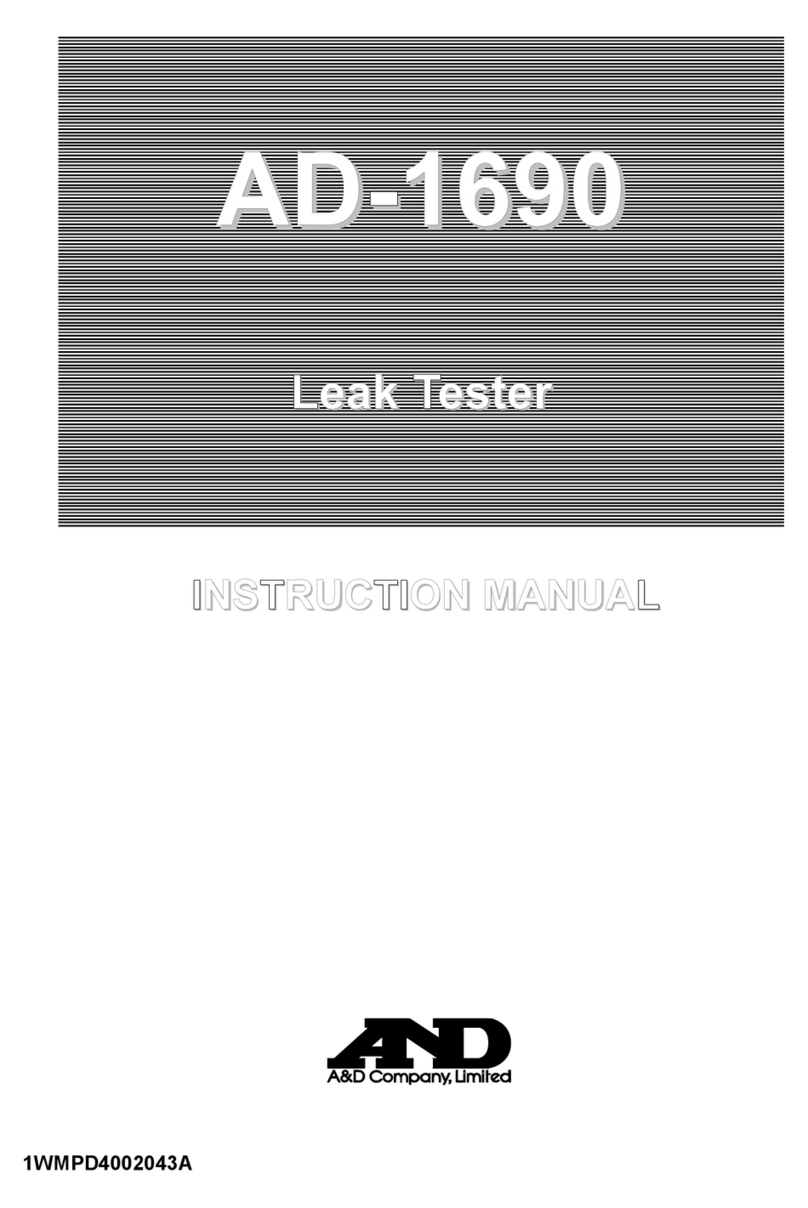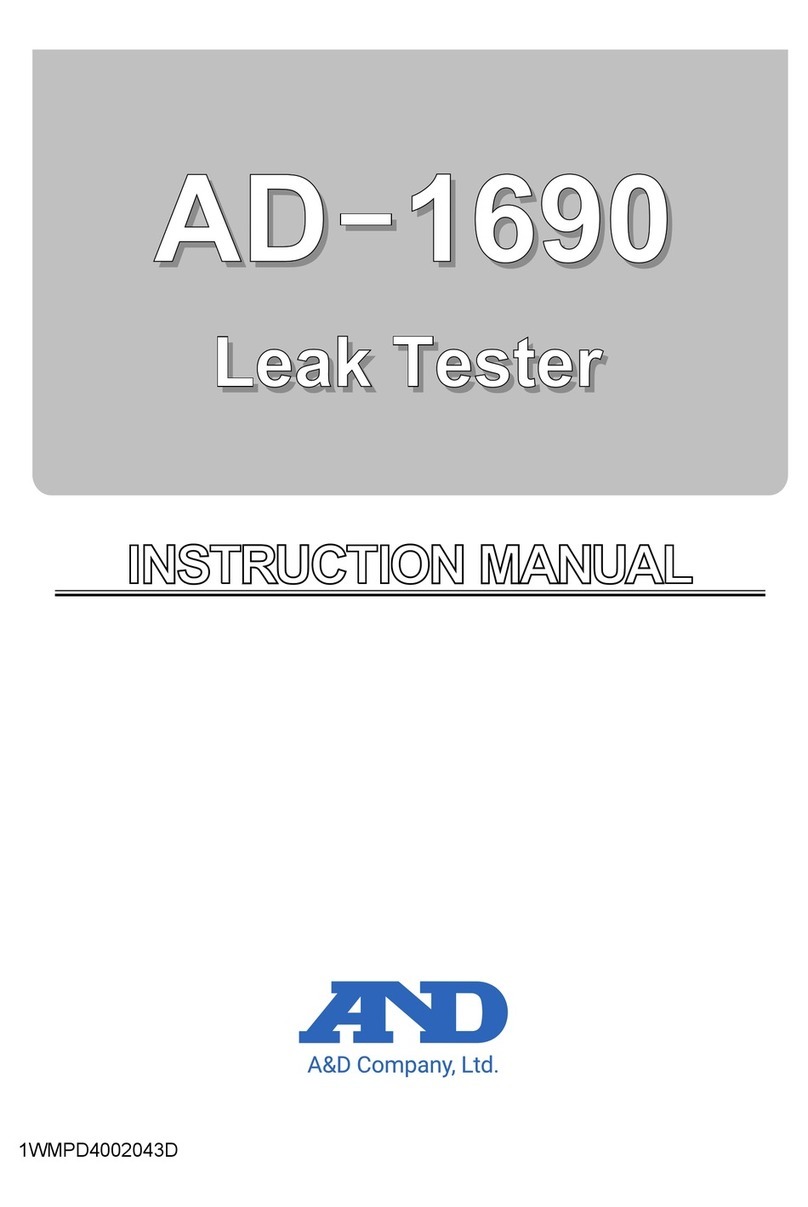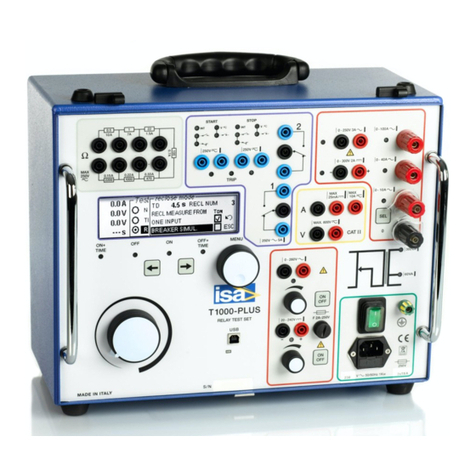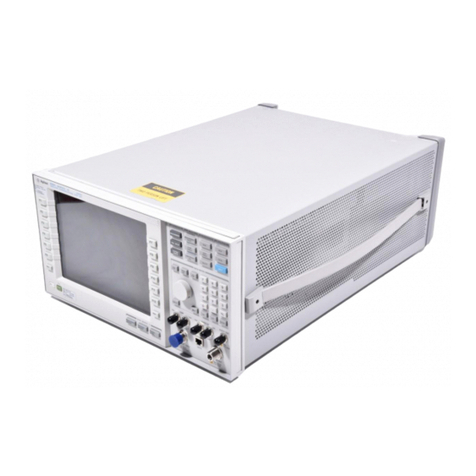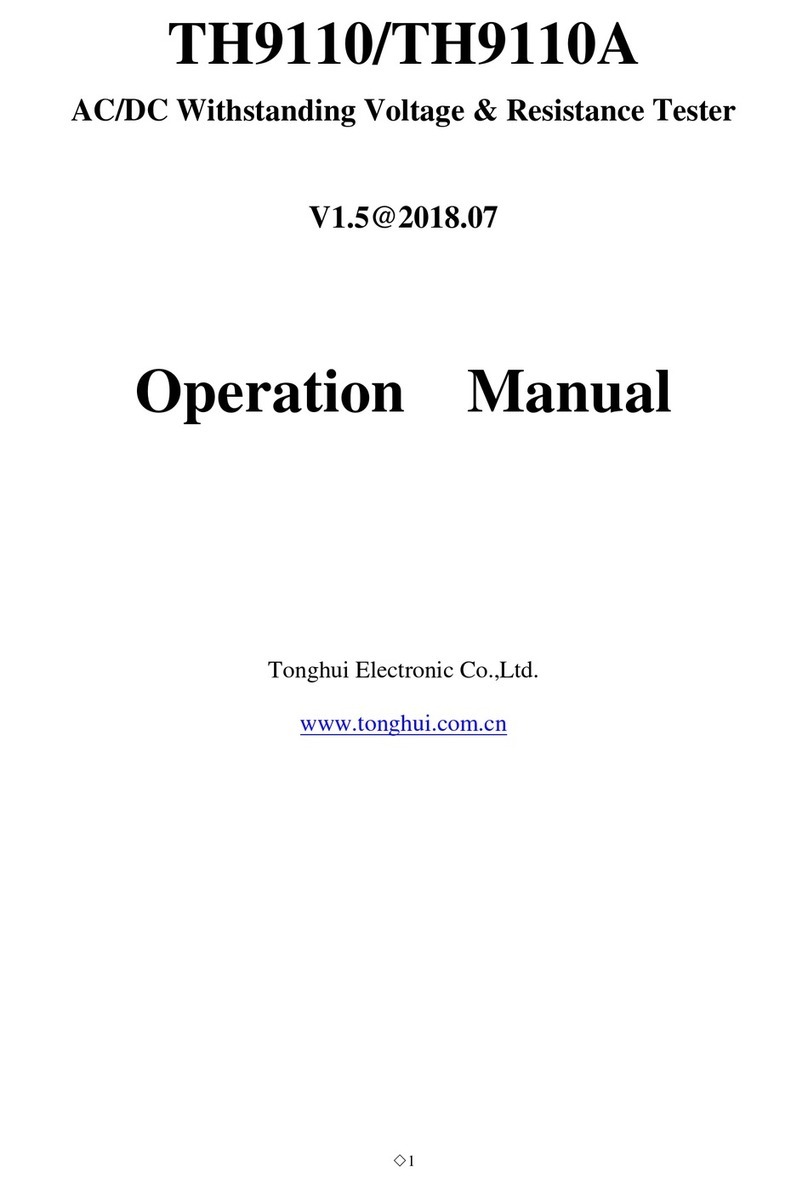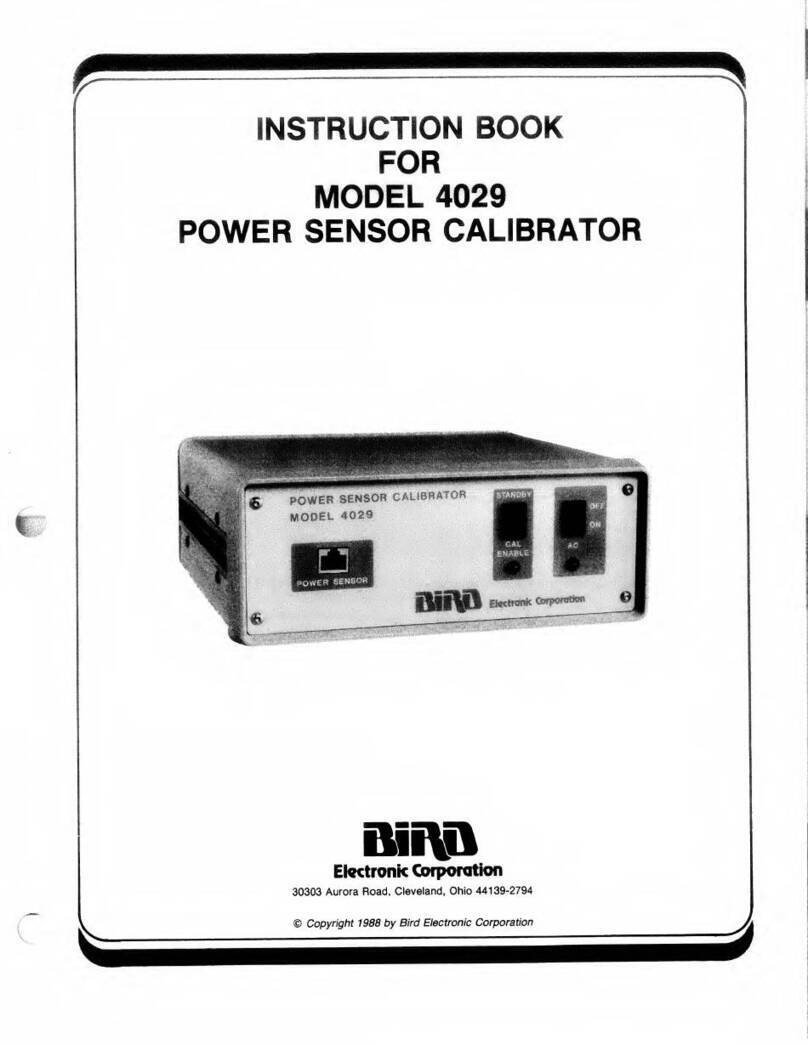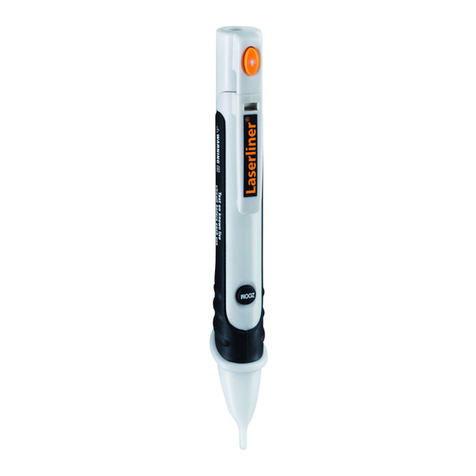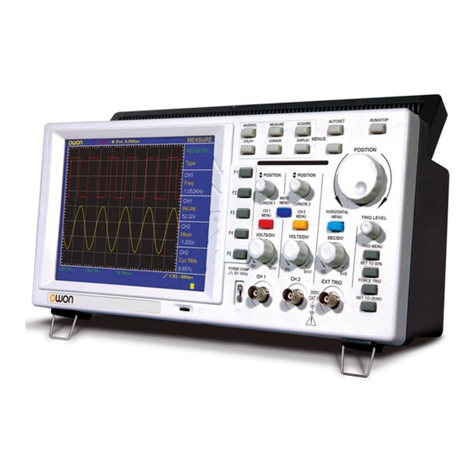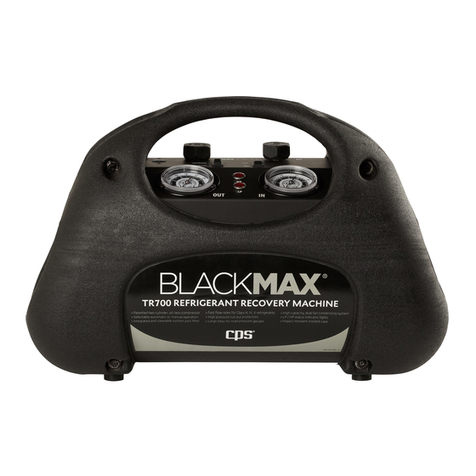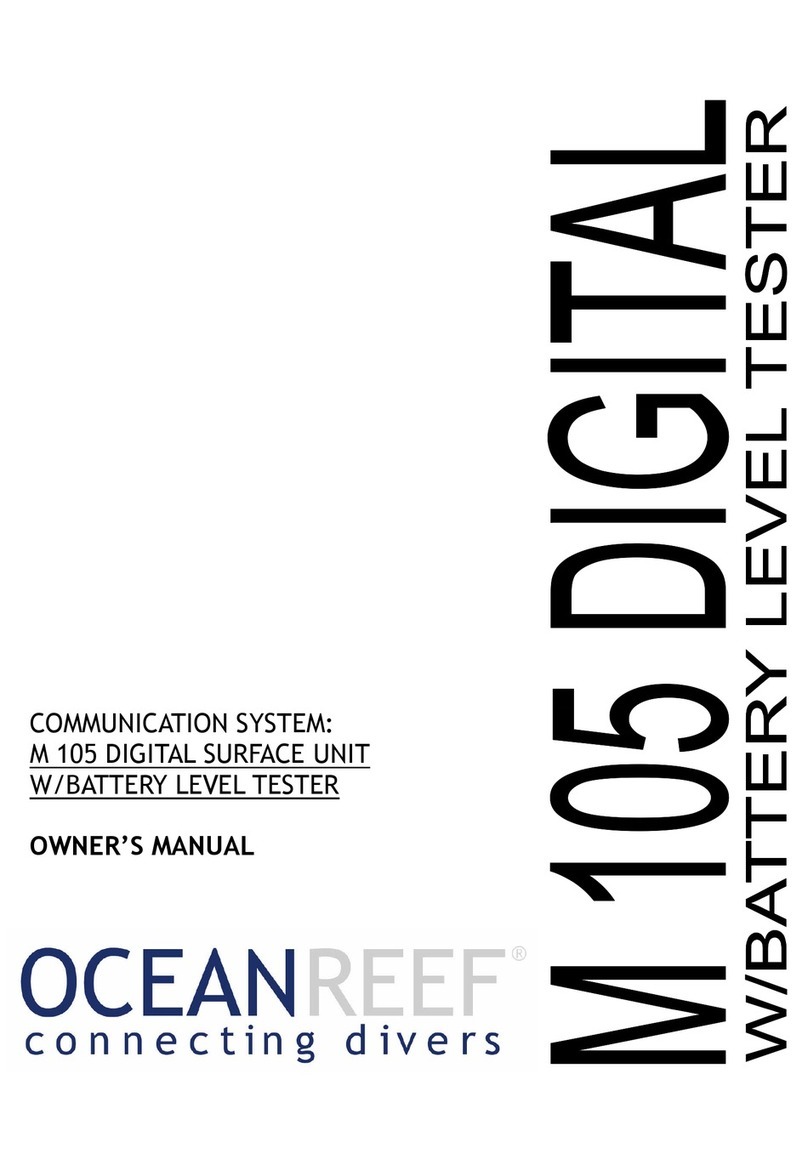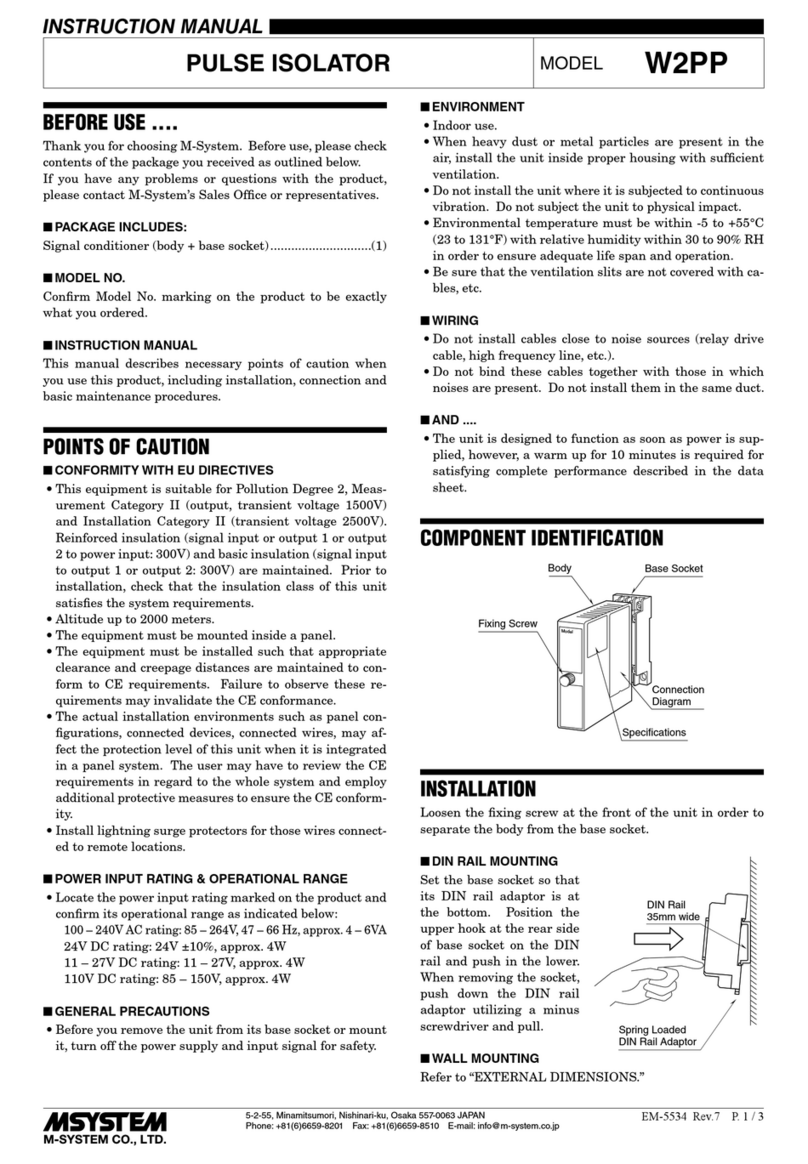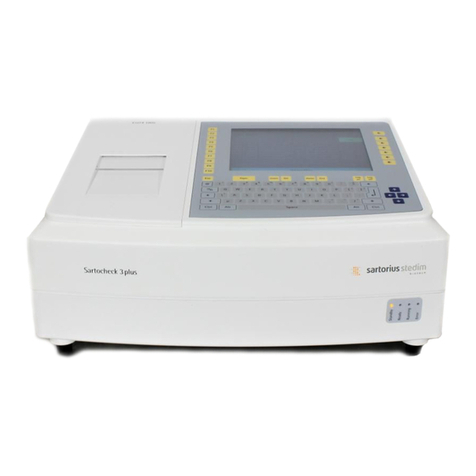AND PT Series User manual

Pipette Accuracy Tester
PT-Series
AD-4212B-PT
AD-4212A-PT
FX-300i-PT
INSTRUCTION MANUAL
1WMPD4001794A

© 2011 A&D Company, Limited. All rights reserved.
No part of this publication may be reproduced, transmitted, transcribed, or translated
into any language in any form by any means without the written permission of A&D
Company, Limited.
The contents of this manual and the specifications of the instrument covered by this
manual are subject to change for improvement without notice.
Microsoft, Windows, Excel and Word are either registered trademarks or trademarks of
Microsoft Corporation in the United States and/or other countries.

1
CONTENTS
1. INTRODUCTION .............................................................................................................................2
1-1 Unpacking the Tester.......................................................................................................................... 2
1-2 Description of Each Component......................................................................................................... 3
1-3 WinCT-Pipette, Software for Pipette Accuracy Testing....................................................................... 4
1-4 Function of the Evaporation Trap ....................................................................................................... 5
1-5 Description of a Sample Cup.............................................................................................................. 5
2. ASSEMBLING THE TESTER..........................................................................................................6
2-1 AD-4212B-PT / AD-4212A-PT ............................................................................................................ 6
2-2 FX-300i-PT ......................................................................................................................................... 8
3. PRECAUTIONS BEFORE USE ....................................................................................................10
4. ANTI-STATIC TREATMENT..........................................................................................................11
5. INSTALLING WinCT-Pipette ........................................................................................................11
6. CONNECTING A PC TO THE BALANCE.....................................................................................12
6-1 Connecting a PC .............................................................................................................................. 12
6-2 Checking COM Port Numbers.......................................................................................................... 13
7. CALIBRATING THE BALANCE ...................................................................................................14
7-1 AD-4212B-PT / AD-4212A-PT .......................................................................................................... 14
7-2 FX-300i-PT ....................................................................................................................................... 15
8. PREPARATION BEFORE USE.....................................................................................................16
8-1 Filling the Evaporation Trap with Water............................................................................................ 16
8-2 Preparing the Test Liquid.................................................................................................................. 16
8-3 Preparing the Water-absorbent Sheet.............................................................................................. 16
8-4 Using the Thermometer.................................................................................................................... 17
9. MEASUREMENT ..........................................................................................................................21
9-1 Measuring Procedure ....................................................................................................................... 21
9-2 Judging the Results .......................................................................................................................... 21
9-3 Example Causes of Measurement Errors ........................................................................................21
10. AD-4212B-PT / AD-4212A-PT ....................................................................................................23
10-1 Factory Settings.............................................................................................................................. 23
10-2 Display Lock Function .................................................................................................................... 24
10-3 Auto Print Mode .............................................................................................................................. 24
11. TROUBLESHOOTING ................................................................................................................25
12. SPECIFICATIONS.......................................................................................................................26
12-1 Options ........................................................................................................................................... 27
13. APPENDIX ..................................................................................................................................28

2
1. INTRODUCTION
The PT series Pipette Accuracy Tester performs an accuracy test of the volume of a pipette in
accordance with ISO 8655.
This manual describes how the PT series Pipette Accuracy Tester works and how to get the most out
of it in terms of performance. It includes how to assemble the tester, how to measure and how to use
the software, WinCT-Pipette, for pipette accuracy testing.
Read this manual thoroughly before using the tester and keep it at hand for future reference.
For detailed information on handling the balance, refer to the instruction manual for the balance used.
NOTE ISO 8655 is the international standard that includes pipette calibration and specifies a test
method for accuracy of the pipette volume. For detailed information, visit our web site.
1-1 Unpacking the Tester
NOTE The pipette accuracy tester is contained in a carrying case. The case is only for
carrying the tester and is not solid enough to endure transportation. So, do not
transport the tester using the carrying case. When transporting the tester, be sure to
use the original packing material.
When handling the tester, be careful not to drop it, even if it is placed in the carrying case.
The illustrations below show what the PT series consists of. Note that the USB converter is shipped
in a separate package, but it can be placed in the carrying case as shown below.
A shoulder belt and a key are provided with the carrying case. Use the shoulder belt to carry the case.
NOTE Please confirm that the AC adapter type is correct for your local voltage and power
receptacle type.
AD-4212B-PT / AD-4212A-PT
The connection cable provided as an accessory is one meter long.

3
FX-300i-PT
1-2 Description of Each Component
zEvaporation trap
A chamber to prevent the evaporation of the dispensed test liquid (distilled water).
(Refer to “1-4 Function of the Evaporation Trap”.)
zSample cup (Two types: 5 mL and 30 mL)
A measuring cup to contain the test liquid dispensed from a pipette, with a
water-absorbent sheet installed, to prevent water droplets from remaining on
the edge of the pipette tip.
zTest liquid cup
A container to keep a test liquid such as distilled water.
zThermometer (with a clamp)
Measures the temperature of the test liquid.
zRS-232C cable and USB converter
Connects to a PC (personal computer) to transmit the test values to the PC.
zWinCT-Pipette
Software for pipette accuracy testing to convert the test liquid mass
into a volumetric value.
zCalibration weight (with a pair of tweezers to handle the weight)
A weight to calibrate the balance.

4
1-3 WinCT-Pipette, Software for Pipette Accuracy Testing
Features
The mass value of the distilled water dispensed from a pipette is transmitted from the balance to a
PC. Using the temperature of the test liquid and the barometric pressure that are previously entered,
the PC calculates the conversion factor (Z factor) from a mass value to a volumetric value and
converts the mass value into a volumetric value automatically, using the Z factor.
The measurement results are compared with the specifications previously entered, to perform
judgment whether the pipette will pass or fail.
Besides the pipette volume, test numbers, test dates and pipette information (manufacturer, model,
serial number) can be recorded as test data. The test data, output to a printer or stored in the PC,
allows easy management of pipette accuracy and reduces errors due to data mismanagement.
The specifications of accuracy and repeatability can be entered either as an absolute value (μL)
or as a relative value (percentage to the pipette volume).
The mass value data from the balance can be transmitted to the PC either using a COM port or
using a USB connection. (For a USB connection, use the accessory USB converter.)
For testing various pipettes easily, multiple test conditions (pipette volume, number of
measurements and specifications) can be set previously. When multiple operators are set
previously, an operator can be selected easily as necessary.
NOTE For detailed information on WinCT-Pipette, refer to “How to use WinCT-Pipette.pdf” in the
WinCT-Pipette CD-ROM.
Main Window
When WinCT-Pipette starts up, the window below opens
Specifications
Enter the pipette volume, specifications of
accuracy and repeatability used for
pass/fail judgment.
Measured Values
Displays the mass values transmitted from the
balance and the volumetric values obtained
using the Z factor.
Measurement Results
Displays the measurement results and
judgment results.
The Z factor is automatically calculated using the values o
f
the distilled water temperature and the barometric pressure.
Measurement environment
Enter the ambient relative humidity,
the distilled water temperature and
the barometric pressure.

5
1-4 Function of the Evaporation Trap
In the pipette accuracy test using the gravimetric method, to obtain the mass of the test liquid, distilled
water is dispensed from the pipette into the sample cup installed on the balance. The obtained value,
however, is generally smaller due to evaporation loss of the test liquid. To prevent evaporation of the test
liquid, the evaporation trap is used. The ISO 8655 standard recommends that the humidity of the
measurement environment be greater than 50% RH.
Water is poured into the groove of the evaporation trap. This helps to maintain the humidity inside
the evaporation trap high and reduces evaporation. Using the evaporation trap reduces the
evaporation of the test liquid, compared with the value when the evaporation trap is not used. This
yields a measurement environment where there is no need to consider measurement errors due to
evaporation loss of the test liquid.
Another function of the evaporation trap is one as a breeze break, to prevent drafts in the
measurement environment from influencing the weighing operation and enable a stable weighing.
The evaporation trap is designed for an easy dispensing of the test liquid. The upper part has a
sloped surface so that the pipette can be inserted from obliquely above.
1-5 Description of a Sample Cup
When dispensing a test liquid from the pipette, to perform an accuracy test of the volume of a pipette, a
possible cause of errors is water droplets remaining on the edge of the pipette tip. Using the
water-absorbent sheet in the sample cup prevents this and increases the accuracy of a test.
As shown in the illustration below, a water-absorbent sheet is rolled into a cylinder and is placed
along the inner wall of the sample cup.
By dispensing the test liquid with the edge of the pipette tip touching the sheet, the sheet will absorb
any droplet which may otherwise remain on the edge of the tip. Thus all the test liquid will be
dispensed into the sample cup.
The water-absorbent sheets are made of a RoHS-compliant material for safety.
The sheet, once used, can be cleaned and used repetitively.

6
Stand
A
ngle
adjustment
knob
Weighing
unit
Display
Connection
cable
Sample cup
holder (5 mL)
5 mL sample
cup
30 mL sample
cup
Sample cup
holder (30 mL)
2. ASSEMBLING THE TESTER
2-1 AD-4212B-PT / AD-4212A-PT
1. Place the weighing unit on a solid table. For details
on the installation site, refer to “3. PRECAUTIONS
BEFORE USE”.
Secure the display to the stand using the angle
adjustment knobs. Connect the display and the
weighing unit using the connection cable.
2. Install the evaporation trap base on the weighing
unit.
3. Install the sample cup holder (30 mL) on the base.
When the 30 mL sample cup is used:
Insert the sample cup into the holder.
When the 5 mL sample cup is used:
Insert the sample cup holder (5 mL) into
the sample cup holder (30 mL), and then
insert the sample cup
Evaporation
trap
base

7
4. Install the lower part of the evaporation trap on the
weighing unit, mating the tabs with the holes on the
base.
5. Attach the upper part of the evaporation trap to the
lower part, mating the tab with the notch.
6. Adjust the direction of the evaporation trap so that the pipette insertion opening on the sloped
surface is faced to allow easy operation.
7. Install cap B on the evaporation trap.
Remove cap A from the sloped surface.
Lower part of
the evaporation trap
Lower part of
the evaporation trap
Upper part of
the evaporation trap
右 左
Pipette
insertion
opening
Pipette
insertion
opening
Facing to the right
of the weighing unit
Facing to the left
of the weighing unit
Cap B
Cap A
Upper part of
the evaporation trap
Tab
Hole
Tab
Notch

8
2-2 FX-300i-PT
1. Place the balance on a solid table.
For details on the installation site, refer to
“3. PRECAUTIONS BEFORE USE”.
.
2. Install the fitting boss on the balance, then install
the evaporation trap base on the fitting boss.
3. Install the sample cup holder (30 mL) on the base.
When the 30 mL sample cup is used:
Insert the sample cup into the holder.
When the 5 mL sample cup is used:
Insert the sample cup holder (5 mL) into
the sample cup holder (30 mL), and then
insert the sample cup
Evaporation
trap
base
Fitting
boss
Sample cup
holder (5 mL)
Sample cup
holder (30 mL)
5 mL sample
cup
30 mL sample
cup

9
4. Install the lower part of the evaporation trap on the
weighing unit, mating the tabs with the holes on the
base.
5. Attach the upper part of the evaporation trap to the
lower part, mating the tab with the notch.
6. Adjust the direction of the evaporation trap so that the pipette insertion opening on the sloped
surface is faced to allow an easy operation.
7. Install cap B on the evaporation trap.
Remove cap A from the sloped surface.
Lower part of
the evaporation trap
Upper part of
the evaporation trap
Cap B
Cap A
Upper part of
the evaporation trap
Lower part of
the eva
p
oration tra
p
右 左
Pipette
insertion
opening
Pipette
insertion
opening
Facing to the right
of the balance
Facing to the left
of the balance
Tab
Hole
Tab
Notch

10
3. PRECAUTIONS BEFORE USE
To get the optimum performance from the balance and acquire accurate weighing data, note the
following, especially when using the AD-4212B-PT / AD-4212A-PT with a minimum weighing value of
0.001 mg / 0.1 mg.
Install the balance where the measurement environment is appropriate. The best operating
temperature is 15°C to 30°C ±0.5°C with greater than 50% RH.
Install the balance where it is not exposed to direct sunlight and it is not affected by air from
heaters or air conditioners. Especially be careful when using the AD-4212B-PT. It responds
even to very subtle air flow.
Install the balance where it is free of dust.
Install the balance away from equipment which produces magnetic fields.
Install the balance in a stable place avoiding vibration and shock. Corners of rooms (close to
pillars or walls) far from a passage way are best, as they are less prone to vibration.
The weighing table should be solid and free from vibration, drafts and as level as possible.
Level the balance by adjusting the leveling feet and confirm it using the bubble spirit level.
Before use, warm up the balance for the appropriate duration, with nothing on the weighing pan.
AD-4212B-PT / AD-4212A-PT: one hour or more
FX-300i-PT: 30 minutes or more
When using the AD-4212B-PT with a minimum weighing value of 0.001 mg, keep the balance
connected to power constantly.
Calibrate the balance before use or after having moved it to another location. Use the
accessory calibration weight for calibration. For details, refer to “7. CALIBRATING THE
BALANCE”.
Caution
Do not install the balance where flammable or corrosive gas is present.

11
4. ANTI-STATIC TREATMENT
An anti-static treatment has been applied to the evaporation trap. Cleaning it with alcohol will reduce
the effect of the treatment.
If the evaporation trap has acquired a static charge, apply an anti-static agent or use the optional
AD-1683 DC static eliminator to remove the static electricity.
5. INSTALLING WinCT-Pipette
For detailed information on the WinCT-Pipette program, refer to “How to use WinCT-Pipette.pdf ” in
the WinCT-Pipette CD-ROM.
For installing WinCT-Pipette, refer to “Readme.txt” in the WinCT-Pipette CD-ROM.
System requirements
OS Windows XP SP2 or later
CPU Pentium or the equivalent, 1GHz or more recommended
RAM 512 MB or more recommended
Hard disk available space Approximately 50 MB
Display 1024 x 768 or more recommended

12
6. CONNECTING A PC TO THE BALANCE
To make a connection between a PC and the balance, use the RS-232C cable or use both the
RS-232C cable and the USB converter.
6-1 Connecting a PC
When a PC COM port is used
When using the COM port of a PC to make a connection to the balance, use the accessory RS-232C
cable.
AD-4212B-PT / AD-4212A-PT FX-300i-PT
When a PC USB port is used
When using the USB port of a PC to make a connection to the balance, use both the accessory
RS-232C cable and the USB converter (shipped in a separate package).
The USB converter, when connected to the USB port of a PC, adds a COM port to the PC. When
connecting the USB converter to the USB port for the first time, installing a driver is required. (Some
PCs may require a driver installation even when the USB port used is changed.)
The driver installation CD and the instruction manual are contained in the same package with the
USB converter. For instructions on installation, read the manual.
After driver installation, connect the USB converter to the balance, using the RS-232C cable. Now a
COM port is added and communications between the PC and the balance is enabled.
NOTE Although the USB converter is shipped in a separate package, it can be placed in the
carrying case.
AD-4212B-PT / AD-4212A-PT FX-300i-PT
Personal computer Personal computer
USB converter USB converter
RS-232C cable
RS-232C interface AC adapter jack
Weighing unit
connection jack
RS-232C cable
RS-232C interface
AC adapter jack

13
6-2 Checking COM Port Numbers
COM port numbers vary depending on the PC used. Use the Windows Device Manager to check COM
port numbers.
NOTE When the USB converter is used, check the COM port number with the USB converter
connected.
1 Click [Start], [Settings] and [Control Panel].
2 Double-click [System].
3 Click [Hardware] and [Device Manager].
4 Double-click [Port (COM & LPT)]. COM port numbers will be displayed.
When the USB converter is used, “ATEN USB to Serial Bridge (COMx)” appears.
In the example below, the COM port number is 4.
The COM port for a personal computer is displayed as “Communications Port (COMx)”.
In the example below, the personal computer has two COM ports. Therefore, two COM ports
appear; “Communications Port (COM1)” and “Communications Port (COM2)”
Change the WinCT-Pipette COM port number to that of the COM port used.
Checking COM port numbers in [Device Manager]

14
7. CALIBRATING THE BALANCE
For details on calibration, read the balance instruction manual in addition to this manual.
Before calibration, refer to “3. PRECAUTIONS BEFORE USE”. Especially when calibrating the
AD-4212B-PT / AD-4212A-PT with a minimum weighing value of 0.01 mg / 0.1 mg, make sure that the
installation environment is appropriate and the balance is warmed up for the appropriate duration.
7-1 AD-4212B-PT / AD-4212A-PT
1. Remove the sample cup, but leave two
sample cup holders (5 mL and 30 mL) inside
the evaporation trap, as shown to the right.
2. Press and hold the CAL key until Calout
is displayed, then release the CAL key.
3. When Cal 0 is displayed, press the
PRINT key to enter the zero point.
4. After the zero point is entered, the calibration
weight value 50 is displayed.
Remove the upper part of the evaporation
trap while holding the lower part of the
evaporation trap.
Place the accessory calibration weight on the
sample cup holder (5 mL).
Attach the upper part of the evaporation trap
to the lower part, mating the tab with the
notch.
5. Press the PRINT key to calibrate the
weighing capacity. When end is
displayed, remove the calibration weight. The
balance will return to the weighing mode.
6. Place the calibration weight on the sample
cup holder (5 mL) to confirm that calibration
has been completed successfully.
Calibration
weight (50 g)
Tab
Notch
Upper part of
the evaporation trap
Sample cup
holder (30 mL)
Lower part of
the evaporation trap
Sample cup
holder (5 mL)

15
7-2 FX-300i-PT
1. Remove the 30 mL sample cup and leave
only the sample cup holder (30 mL) inside
the evaporation trap as shown to the right.
2. Press and hold the CAL key until Calout
is displayed, then release the CAL key.
3. When Cal 0 is displayed, press the
PRINT key to enter the zero point.
4. After the zero point is entered, the calibration
weight value 100 is displayed.
Remove the evaporation trap by holding the
lower part of the evaporation trap.
Place the accessory calibration weight on the
sample cup holder (30 mL).
Attach the evaporation trap on the base,
mating the tabs with the holes.
5. Press the PRINT key to calibrate the
weighing capacity. When end is
displayed, remove the calibration weight. The
balance will return to the weighing mode.
6. Place the calibration weight on the sample
cup holder (30 mL) to confirm that calibration
has been completed successfully.
NOTE The evaporation trap can be used as a breeze break.
Calibration can be performed, using the weighing pan and the breeze break provided
as accessories.
Upper part of
the evaporation trap
Lower part of
the evaporation trap
Sample cup
holder (30 mL)
Calibration
weight (100 g)
Tab
(4 in all)
Hole
(
4 in all
)
Base

16
8. PREPARATION BEFORE USE
The measurement environment recommended by ISO 8655 is as follows.
Temperature: Constant between 15°C and 30°C, changes in temperature ±0.5°C.
Humidity: Greater than 50% RH
8-1 Filling the Evaporation Trap with Water
Remove the evaporation trap from the balance. Separate the upper and lower part of the evaporation trap.
Pour water into the groove along the circumference of the inner wall of the lower part of the evaporation trap,
using a wash bottle or a pipette, up to the center between the two lines on the evaporation trap.
NOTE When pouring water, use much care
not to spill water around the fitting
boss of the balance weighing pan.
Attach the upper part of the evaporation trap to the lower part and place the evaporation trap on the
balance or weighing unit.
It takes approximately 15 minutes for the humidity inside the evaporation trap to stabilize to about 85% RH.
The time required for the humidity to stabilize varies depending on the measurement environment.
8-2 Preparing the Test Liquid
Pour distilled water into the test liquid cup.
Place the thermometer in the cup, using the clamp as shown below.
Leave as is to allow the temperature of the distilled water to stabilize. ISO 8655 recommends that
the test liquid be acclimatized to the measurement environment for two hours or more.
8-3 Preparing the Water-absorbent Sheet
To stabilize the evaporation amount of the dispensed test liquid from the sheet, moisten the sheet
with the test liquid (approx. 600μL for the 5-mL sample cup sheet, and approx. 4000μL for the 30-mL
sample cup sheet) before the test.
Wash bottle
Water level
reference lines
Lower part of
the evaporation trap
Thermometer
Clamp
Test liquid cup
Insert the thermometer
into the cup so that the
clamp is hooked on the
edge of the cup.

17
MAX / MIN
ON / FAST AUTO-OFF
1
2
3
4
5
6
7
8-4 Using the Thermometer
Part names
Front Back
1: LCD
2: ON/FAST button
3: MAX/MIN button
4: Sensor sheath
5: AUTO-OFF button
6: Sheath protector
7: Battery cover
Before use
One LR-44 battery is provided with the thermometer. It is for testing the performance of the
thermometer and may have a limited life. Before use, install the battery as described in “Replacing
the battery” below.
Replacing the battery
When the LCD becomes blurred, replace the battery as follows.
1. Place the thermometer on a table with the back
up. Using a coin, rotate the battery cover
anti-clockwise to remove it.
2. Remove the old battery.
3. Install a new battery, with the + side (flat side)
facing up.
4. Using the coin, reattach the battery cover.
NOTE •Be sure to face the + side up when installing a battery.
•Use the specified battery only.
•Do not disassemble, heat, short-circuit, dispose of in fire or attempt to recharge the
battery. It may explode or leak and cause personal injury.
•Keep the battery out of the reach of children. If swallowed, consult a physician
immediately.
•Follow the local regulations when disposing of a used battery.
•To keep the thermometer watertight, do not damage the rubber ring or remove it
from the battery compartment.
Coin
Battery cover
Battery (LR-44)

18
Displaying modes
The thermometer has three display modes.
Displaying mode Display example
•Current temperature mode
Displays the current temperature.
Maximum temperature
•Max/Min temperature mode
Displays the latest maximum and
minimum temperatures that are
automatically stored in the thermometer. Minimum temperature
•Auto power-off mode
Turns the power off automatically after six
or seven minutes of no operation.
Measuring the temperature
Follow the procedure below to measure the water temperature.
1. Remove the sheath protector from the
thermometer.
2. Press the ON/FAST button to turn the display on.
3. Insert the sensor sheath into the water.
4. The sampling interval is 10 seconds.
To speed this process, press and hold the
ON/FAST button for a sampling interval of every
2 seconds.
5. As the thermometer responds to the water
temperature, the displayed temperature changes,
stabilizes and then displays the water
temperature.
NOTE The thermometer detects the
temperature at the tip of the sensor
sheath. Do not expose parts of the
thermometer other than the sensor
sheath to the high or low temperature
of the test liquid.
MAX / MIN
ON / FAST AUTO-OFF
Water
MAX / MIN
ON / FAST AUTO-OFF
Temperature
detection
part
Sensor sheath
This manual suits for next models
3
Table of contents
Other AND Test Equipment manuals

